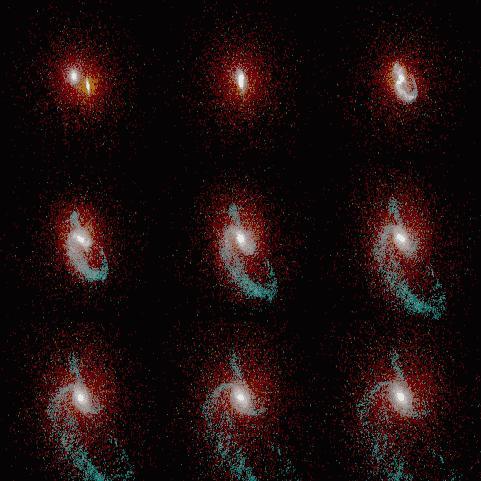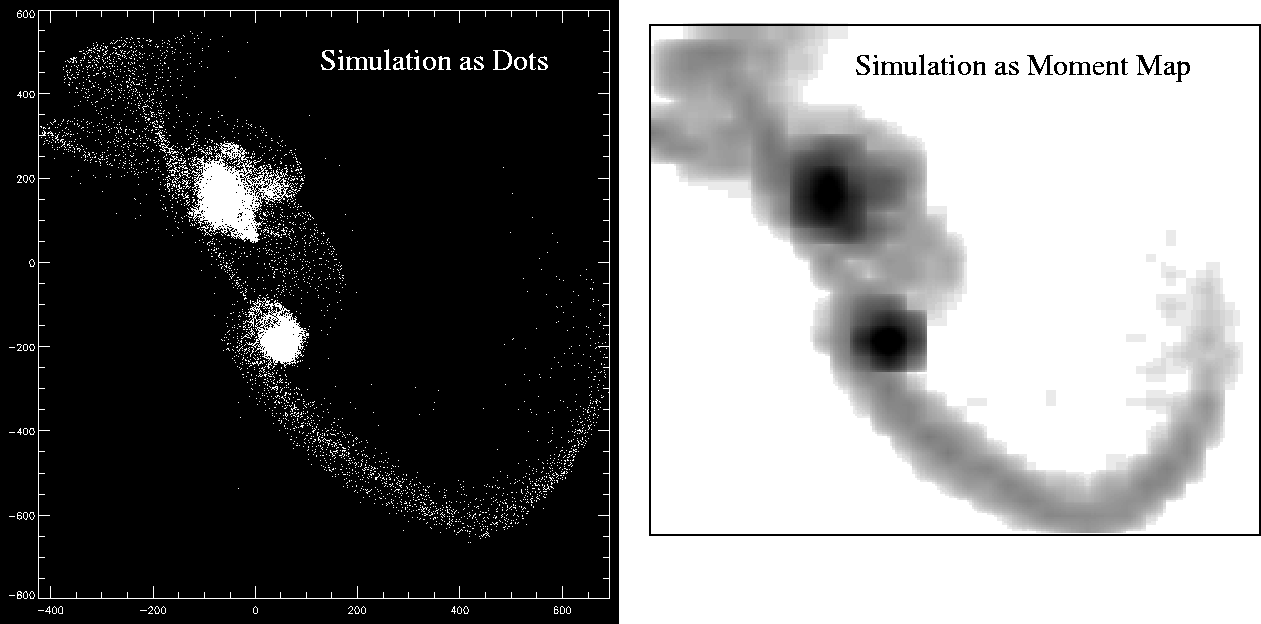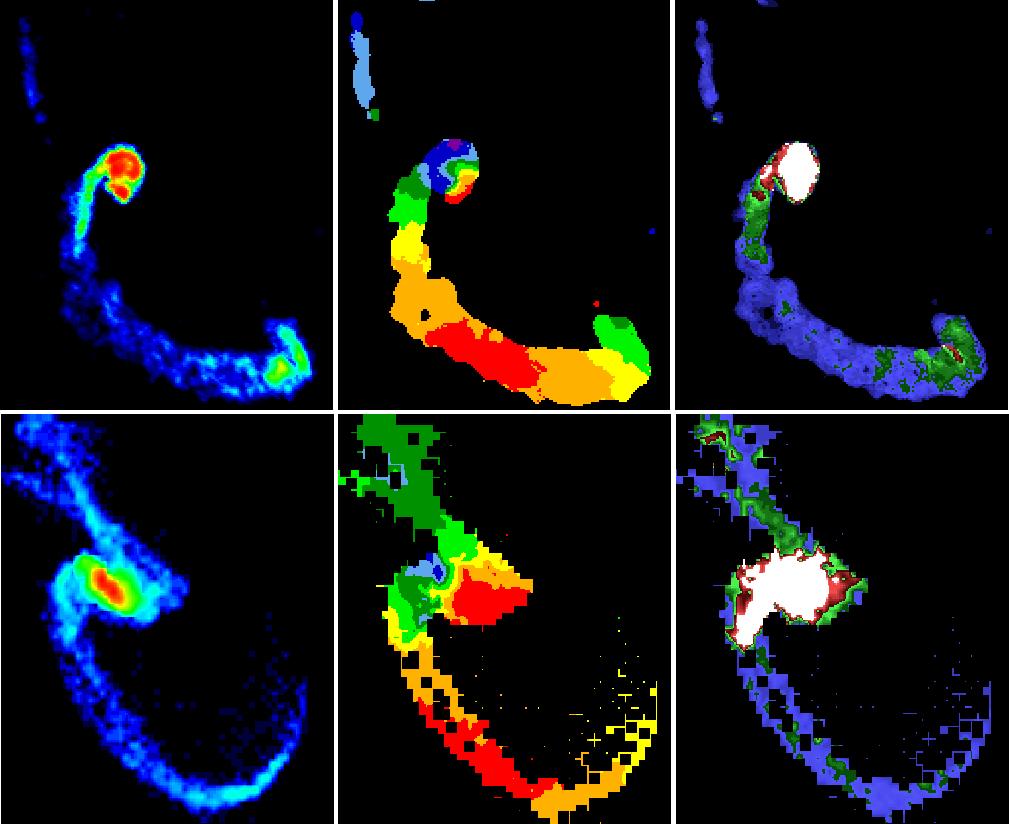N-Body Simulations of Tidal Dwarf Galaxies
Abstract. Theoretical work (Barnes & Hernquist 1992) suggests that dwarf galaxies may form within the tidal tails of interacting disk galaxies. Recent observational work purports to identify several so-called "Tidal Dwarf Galaxies" (TDGs) within tidal debris. However, the observational evidence that these TDGs are distinct dynamical entities is circumstantial or non-existent. The goal of this project was to run numerical N-body simulations of interacting galaxies; to inspect their tidal tails for bound clumps; and to quantify the expected observational signatures of such clumps. The project involved identifying and downloading software to run the simulations (GADGET and Zeno), to visualize the results (TIPSY, StarSplatter and mpeg_encode), and to identify bound subunits (SKID and Zeno). The N-body results were analyzed and converted into simulated observations (moment maps) by specially written IDL macros.
1. Introduction
When two disk galaxies collide, tidal forces between them can draw out long `bridges' and `tails' of gas and stars. It has been proposed that self-gravitationally bound clumps may form within these tidal tails and subsequently evolve into independent dwarf galaxies. One potentially bound clump has been found at the end of the southern tail of the Antennae galaxy, NGC4038/9. The total luminosity, hydrogen mass and dynamical mass of this object seem similar to that of typical dwarf irregular galaxies. (Schweitzer 1978, Mirabel et al. 1992) Similar clumps have also been observed in the tidal tails of NGC7252 (Schweitzer 1978, Hibbard et al. 1994) and IRAS19254-7245. (Zwicky 1956, Colina et al. 1991)
In order to simulate merging galaxies that produce self-gravitationally bound structures in their tidal tails, one must employ self-consistent models with ~105 particles. Barnes and Hernquist (1992) used a combined N-body/SPH code to simulate such a merger. Their galaxy models each contained a central bulge, an exponential disk, and a spheroidal dark matter halo with a total N=90,112. Both galaxies developed tidal features after their first passage, and bound structures developed in the tails even before the two galaxies merged. The most massive dwarf that formed in the tail contained ~360 particles and had a mass of 0.0019 units, of which ~25% was gas and <5% was dark matter. Using a `friends-of-friends' algorithm, Barnes and Hernquist identified about 23 additional objects containing 12 or more particles in the tidal tails. Unlike the most massive object, the other objects were gas-poor and were confined to the outer tidal tails.
The integrated properties of these simulated objects are similar to those of some dwarf galaxies. For example, the most massive objects (~108 Msun) have projected surface densities > 102 Msun pc-2, high gas contents, and substantial intermediate-age stellar populations, resembling dwarf irregular (dIrr) galaxies. In addition, lower-mass objects, with lower surface densities and lacking the raw materials for star formation, may resemble dwarf spheroidal (dSph) galaxies. In either case, Barnes and Hernquist determined that mass-to-light (M/L) ratios should be small since the objects capture and retain very little dark matter from their parents' haloes.
Klessen and Kroupa (1998; hereafter KK98) describe some of the properties of the nine known dSph galaxies orbiting the Milky Way at distances ranging from a few tens to a few hundred kpc. If these systems are in virial equilibrium and their velocity dispersions are isotropic, their overall mass can be determined from the observed velocity dispersion. M/L is determined by comparing this gravitational mass to the luminosity of the system. Values for M/L of about 10 or higher usually imply the presence of dark matter in a system. M/L values for the dSph satellites have been inferred to be as large as a few hundred, implying that these systems are completely dark matter dominated.
However, KK98 also state that a system can have an apparent high M/L ratio without having a lot of dark matter if it is not in virial equilibrium; i.e., if it is significantly perturbed by Galactic tides. KK98 modeled the long-term evolution of a low mass galaxy without dark matter orbiting the Milky Way, and found that the satellite galaxy evolved to a stable remnant containing ~1% of its original mass, resulting from severe tidal shaping of the initial satellite. To an observer on Earth, such a remnant would appear very similar to a dSph galaxy, with a high observed M/L ratio despite the fact that it contains no dark matter. This may be due to the fact that satellites initially on highly eccentric orbits have inflated line-of-sight velocity dispersions, therefore inflating their observed M/L ratios, (M/L)obs > 10 while (M/L)true < 3. KK98 conclude that at least some of the dSph galaxies orbiting the Milky Way may not be dark matter dominated, and agree with the suggestion made by Barnes and Hernquist that some progenitors of dSph galaxies may have formed as condensations in the tidal tails of merging galaxies.
2. Project Goals
To investigate these results, we were faced with three tasks. The first was to run N-body simulations of merging disk galaxies that produced gravitationally bound clumps in the tidal tails. Our second task was to turn our N-body models into simulated data by calculating moment maps. Moments can be calculated using the following formulas:
![]()


Moment 0 is an integrated "intensity", or the total number of particles in each particular pixel of the map, measured along the line-of-sight z-axis. Moment 1 and moment 2 are velocity-weighted intensities, measured in units of model velocities. Moment 1 basically tells you the velocity of each particular pixel, and moment 2 tells you the velocity dispersion.
Our third task was to identify gravitationally bound clumps in the tidal tails of our simulated galaxies. Measuring physical quantities of these clumps (e.g. surface brightness, velocity dispersion, half-light radius) will enable us to calculate the apparent M/L ratio using the King formula (see Piatek & Pryor, 1995):
 ,
,
where G is the gravitational constant; r1/2 is the half-light radius, i.e., the radius at which the projected surface brightness density decreases by 0.75 mag pc-2; u0 is the central surface brightness; and â 0 is the central line-of-sight velocity dispersion. (This formula assumes that the velocity dispersion is isotropic, i.e. â x=ây= âz).
3. N-Body Simulations
3.1. GADGET and TIPSY
We identified and downloaded GADGET (GAlaxies with Dark matter and Gas intEracT), a code for cosmological N-body/SPH simulations of structure formation. GADGET computes gravitational forces with a hierarchical tree algorithm and represents fluids by means of smoothed particle hydrodynamics. Written by Volker Springel, it is available for download at: http://ibm-2.MPA- Garching.MPG.DE/~volker/gadget/. GADGET comes with a number of example simulations and parameterfiles, one of which contained the initial conditions for a pair of colliding disk galaxies (collisionless). The output of this simulation was 15 snapshot files, which we examined with TIPSY.
TIPSY (Theoretical Image Processing SYstem) is a software package specially designed to display and analyze the results of N-body simulations. One of the tools developed by the NASA HPCC ESS group at the University of Washington, it is also freely available at: http://www-hpcc.astro.washington.edu/tools/TIPSY/. However, TIPSY is not compatible with GADGET files, so we converted our GADGET output into TIPSY format using code written by Volker Springel. Using TIPSY, we were able to zoom in on particular regions of interest in our simulations. We could also select and analyze subsets ("boxes") of particles, such as clumps in the tidal tails of the galaxies, using the makebox command. Another useful command was writebox, which writes the particles in a chosen box to a file, so that we could animate them using a program called StarSplatter.
StarSplatter, which runs under the control of the scripting language Tcl, is available at: http://www.psc.edu/Packages/StarSplatter_Home. We wrote a short Tcl script in StarSplatter that rendered our 15 TIPSY files into tiff images. To animate these images, we converted them to ppm format and then used mpeg_encode. We also unsuccessfully attempted to use SKID to find gravitationally bound clumps in N-body simulations. SKID is compatible with TIPSY files and can be downloaded at: http://www-hpcc.astro.washington.edu/tools/SKID/.
The main problem we encountered using the above method was that there was no way to modify the initial conditions of our GADGET simulation. We decided then to try using the Zeno software system to run our simulations.
3.2. Zeno
Zeno is a simulation software package freely available from Joshua Barnes at: http://www.ifa.hawaii.edu/faculty/barnes/treecode/treeguide.html. It includes makefiles to set up different initial conditions. We ran simulations on Zeno using four different models of pairs of interacting galaxies. Each galaxy was a standard bulge-disk-halo model (for details, see Barnes, 1992). The galaxy models for each simulation are described in Table 1.
|
|
Model 1 |
Model 2 |
Model 3 |
Model 4 |
|---|---|---|---|---|
|
Ntot = (Nbulge+Ndisk+Nhalo) |
34816 |
34816 |
34816 |
32768 |
|
Nbulge |
2048 |
2048 |
2048 |
4096 |
|
Ndisk |
24576 |
24576 |
24576 |
12288 |
|
Nhalo |
8192 |
8192 |
8192 |
16384 |
|
Mtot = (Mbulge+Mdisk+Mhalo) |
1.2500 |
1.2500 |
1.2500 |
2.0000 |
|
Mbulge |
0.0625 |
0.0625 |
0.0625 |
0.0625 |
|
Mdisk |
0.1875 |
0.1875 |
0.1875 |
0.9375 |
|
Mhalo |
1.0000 |
1.0000 |
1.0000 |
1.0000 |
|
z0 |
0.0100 |
0.0100 |
0.0050 |
0.0100 |
|
Ggal1 |
(+70,+290) |
(+50,+290) |
(+70,+290) |
(+70,+290) |
|
Ggal2 |
(-30,+170) |
(+10,+290) |
(-30,+170) |
(-30,+170) |
Table 1. Simulation parameters for 4 different models of pairs of interacting galaxies, giving the total number of particles for each galaxy in the pair (Ntot), number of bulge particles (Nbulge), number of disk particles (Ndisk), and number of halo particles (Nhalo). Each disk mass (Mdisk), bulge mass (Mbulge), and total mass (Mtot) are in relative units with respect to a halo mass (Mhalo) of 1. Disk scale height is given by z0, and the geometries of the two galaxies in each model are given by Ggal1 and Ggal2. The first angle is inclination with respect to the orbital plane, and the second is the "argument of periapse", the angle measured in the orbital plane, between a line connecting the two centers of mass and the "line of nodes" of the disk. The line of nodes of a disk is the intersection of the galaxy disk and the orbital plane. (see Toomre & Toomre, 1972)
As an illustration of the generic morphological evolution of our models, we show snapshots of our Model 4 simulation in Figure 1.

4. Converting N-Body Models into Simulated Observations
We wrote IDL programs to calculate and display moment 0,1,2 maps using the formulae mentioned in Section 2. This software did not exist prior to this project, and it is anticipated that it will be a very useful code for comparing simulations to real data in the future. To illustrate our results, we show a comparison between the last snapshot of an N-body simulation (Model 4) and its corresponding moment 0 map in Figure 2. Figure 3 shows a comparison between moment 0,1,2 maps of the Antennae galaxy (NGC 4038/9) and our Model 4 simulation.


5. Future Goals
Our ultimate goal, for which time did not allow in this project, was to calculate mass-to-light (M/L) ratios for bound clumps (tidal dwarf galaxies (TDGs)) in the tidal tails of merging galaxies. The most crucial step in completing this goal is to have software that can identify gravitationally bound groups in N-body simulations. As mentioned, we were not successful with the program SKID, probably due to some problems with scaling factors for the physical units, perhaps as a result of converting our GADGET files to TIPSY format. Another available option is Josh Barnes' clump recognition software in Zeno, which may yield more useful results. Once we can identify bound clumps, we can measure their physical quantities, such as surface brightness, half-light radius, and velocity dispersion; this will enable us to calculate M/L ratios .
The lingering questions are (1) do TDGs leave observational signatures, and (2) could some TDGs evolve to resemble dSph galaxies? Measuring the M/L ratio of such TDGs and comparing them to the M/L ratios of the dSph galaxies orbiting the Milky Way will eventually enable us to answer this question.
6. Conclusions
Throughout this project, we spent a considerable amount of time identifying, downloading, installing, and learning how to use various software packages. Much of the software we initially planned to use (GADGET, TIPSY, SKID) turned out to be less than ideal for the kind of analyses we wished to perform. Nevertheless, we were able to run several simulations of merging galaxies on Zeno and do preliminary analyses on them using IDL. We produced a unique and very useful IDL script that enables one to convert N-body snapshots to moment maps. Had time allowed, we would have been able to utilize an appropriate clump-recognition algorithm and complete our IDL scripts to determine M/L ratios of the TDGs in our simulations.
References
Barnes, J. E. 1992, ApJ, 393, 484
Barnes, J. E. & Hernquist, L. 1992, Nature, 360, 715
Colina, L., Lipari, S. & Macchetto, F. 1991, ApJ, 379, 113-121
Hibbard, J. E., Guhathakurta, P., van Gorkom, J. H., & Schweizer, F. 1994, AJ, 107, 67
Klessen, R. & Kroupa, P. 1998, ApJ, 498, 143
Piatek, S. & Pryor, C. 1995, AJ, 109, 1071
Schweitzer, F. 1978, in Structure and Properties of Nearby Galaxies, eds. Berkhuijsen, E. M. & Wielebinski, R. (Dordrecht: Reidel), 279-285
Toomre, A. & Toomre, J. 1972, ApJ, 178, 623
Zwicky, F. 1956, Ergeb. Exakt. Naturwiss, 29, 344